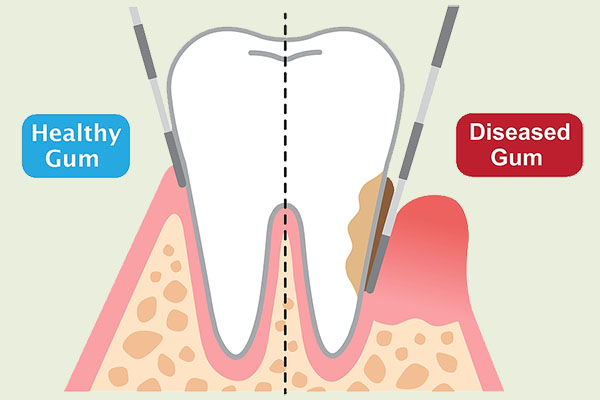
What is periodontal disease?
Periodontal disease, or gum disease is a dental infection that affects the gums, teeth and jaw bone. If periodontal disease is not treated, the infection can destroy gum tissue and jaw bone, leading to tooth loss and impacting physical health.
How does Periodontal Disease Develop?
Periodontal disease is caused by bacteria found in sticky dental plaque that clings to the teeth. When the plaque is not removed, the bacterial colony grows and finds its way into the gums around the tooth, causing a bacterial infection that makes the gums bleed, or gingivitis.
Gingivitis - Healthy Gums Don't Bleed
In the early stages, gingivitis can generally be treated by our dentists and dental hygienists with one or more deep teeth cleanings and irrigation with medicated rinses. If gingivitis treatment is followed by a consistent home care routine of brushing and flossing along with regular visits to the dentist, re-infection can usually be prevented.
Periodontitis or Periodontal Infection
If gingivitis is not treated or harmful oral bacteria finds locations between the teeth and gums where it can thrive, gum tissue will become inflamed and the patient may have foul breath or a bad taste in the mouth.
Left undisturbed, bacterial plaque will form on the tooth roots and harden into calculus. The combination of tissue inflammation, bacteria activity and calculus deposits creates toxins that cause infection; moderate to advanced periodontal infection is destructive to both gum tissue and jaw bone. Infection from periodontal disease can take away millimeters of bone support from around teeth, causing the teeth to become loose.
Regular brushing and flossing alone will not remove tooth calculus or treat periodontal infection.

How is Periodontal Disease Diagnosed?
Our dentists diagnose periodontal disease by using a special instrument to measure the depth of the gum attachment to the teeth (pockets). ‘Deep’ periodontal pockets indicate the gums have pulled away from the tooth, a sign of periodontal disease. The dentist uses periodontal measurements combined with dental x-rays to determine the amount of bone that has been lost to arrive at a diagnosis and treatment recommendations.
What Treatment is Available for Periodontal Disease?
To treat periodontal disease, hard calculus deposits are removed from the tooth root surfaces below the gums and diseased soft tissue is removed from around the teeth to encourage healing and promote healthy tissue growth. This procedure is known as periodontal therapy, or root planing and scaling.
- Our dentists and hygienists provide root planing and scaling treatment after the area is numbed with local dental anesthetic. Periodontal therapy is performed in one or more ‘quadrants’ (the right or left side of the dental arch) per visit; multiple appointments are usually required to complete periodontal therapy.
- In some cases, localized periodontal disease is ‘localized’, or limited to 1-3 teeth due to orthodontic crowding or another dental issue. Localized periodontitis may be treated with root planing along with a regular cleaning to lower bacterial levels in the mouth.
- In cases of extensive periodontal disease, our dentists may refer the patient to a periodontist (gum specialist) for treatment or periodontal surgery. The periodontist will work closely with our dentist to restore the patient's overall dental health.
Restoring Damage from Periodontal Disease
You may have heard about dental surgery procedures such as bone grafting or gum tissue grafting. Our dentists may refer you to a gum specialist (periodontist) for surgical procedures to restore areas that have been damaged by periodontal disease.
Bone grafting procedures are used to repair defects in the bone around teeth following initial periodontal therapy. After accessing the site surgically, the dental surgeon will place a small amount of donor bone in the site; the bone graft material may be obtained from a location on your body or purchased from a tissue bank. The bone graft is held in place with a resorbable membrane and covered with the gum tissue.
The goal of dental bone grafting placement is to encourage new bone cells to grow and attach to the graft; with good management and proper healing, bone density can improve in the site after a few months.
Soft tissue or gum grafts are performed to cover areas of gum recession, fill gum tissue defects, or to restore tissue loss related to periodontal disease. Cosmetic gum grafts may also be performed to smooth an uneven gum line and improve smile appearance.
During gum grafting surgery, a section of gum tissue is obtained from another part of the mouth and placed surgically to cover an exposed tooth surface, or, to repair a deeper void in underlying connective tissue closer to the jaw bone (connective tissue graft).
Dental Implants
Dental implants are tiny titanium cylinders that are placed in the location of a missing tooth to serve as an attachment for a dental crown or other restoration. Dental implants may be used in conjunction with bone and tissue grafting procedures to replace teeth that have been lost due to periodontal disease or other dental problems. Our dentists place dental implants in the comfort of our Dublin dental office. Learn more about dental implants.
Understanding Periodontal Disease begins with a Complete Dental Examination
Periodontal disease poses the greatest risk of tooth loss for adults. Our preventive dental care services are focused on prevention and early detection of dental disease and infection through dental examination and maintenance visits 2-4 times per year.
If you have been treated for periodontal disease in the past, or have not seen a dentist in a while, we invite you to Contact Our Middle Family Dentistry team to schedule an appointment for a complete dental examination to assist you with prevention of periodontal disease.